You’ll get the best clear gaming miniature parts using PETG filament for FDM printing, which offers superior durability and excellent optical properties with minimal post-processing needed. Clear PLA is also user-friendly and works well with proper sanding and polishing. However, if you’re using resin printers, specialized transparent resins like VeroClear and LithaGlass deliver unmatched crystal-clear results that surpass any filament option. Discover the complete guide to achieving professional-grade transparency below.
Understanding Transparency in 3D Printed Gaming Parts
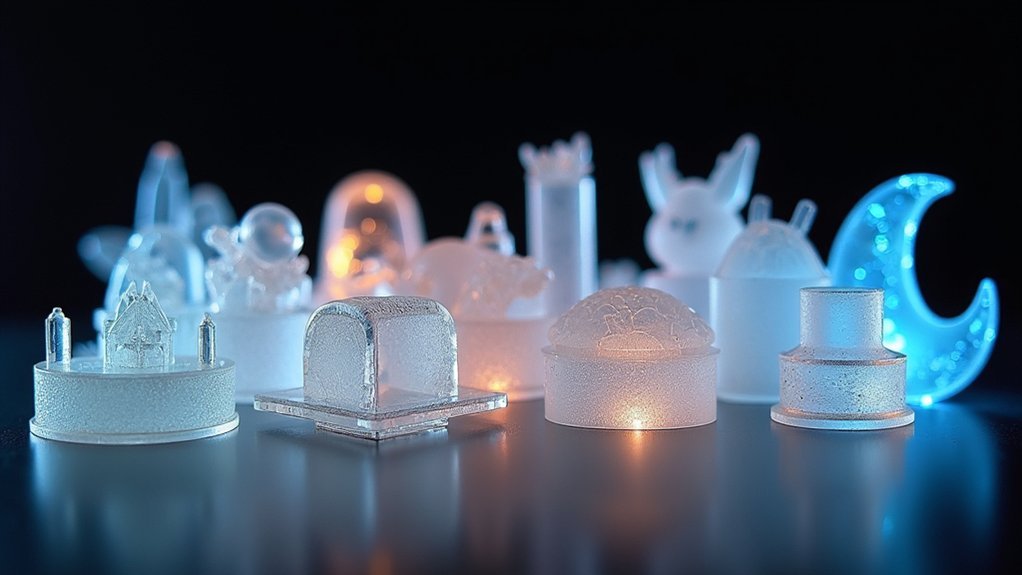
Transparency poses unique challenges when you’re 3D printing gaming miniatures, as the layered nature of additive manufacturing inherently works against optical clarity.
Each layer creates microscopic ridges that scatter light, preventing true transparency from emerging naturally during the printing process.
Layer lines act as tiny prisms, fracturing light paths and destroying the optical clarity essential for professional-quality transparent prints.
FDM printing compounds these challenges through its extrusion method, which introduces air gaps and visible layer lines that disrupt light transmission.
The internal structure of your prints, including infill patterns and shell thickness, directly impacts how light travels through the material.
Achieving clear 3D prints requires understanding these fundamental obstacles.
Layer adhesion, print temperature, and cooling settings all influence final transparency.
Without proper planning, even premium clear filaments won’t deliver the optical clarity you’re seeking.
Post-processing becomes essential for overcoming these inherent limitations.
Clear PLA Filaments for Miniature Components
Clear PLA filaments offer hobbyists an accessible entry point into transparent gaming miniature components, combining user-friendly printing characteristics with reasonable optical results.
You’ll find these biodegradable materials perfect for creating decorative transparent parts that maintain durability during gameplay handling.
Your printing settings should target temperatures between 190°C to 220°C for best layer adhesion without bubbling issues.
While clear PLA won’t match resin’s optical clarity, you can greatly improve translucency through good post-processing techniques like sanding and polishing.
The material’s reduced brittleness compared to other transparent options makes it ideal for miniature components that require both visual appeal and structural integrity.
You’ll appreciate clear PLA’s forgiving nature as you develop skills in creating transparent gaming accessories and decorative elements.
PETG Performance in Transparent Gaming Accessories
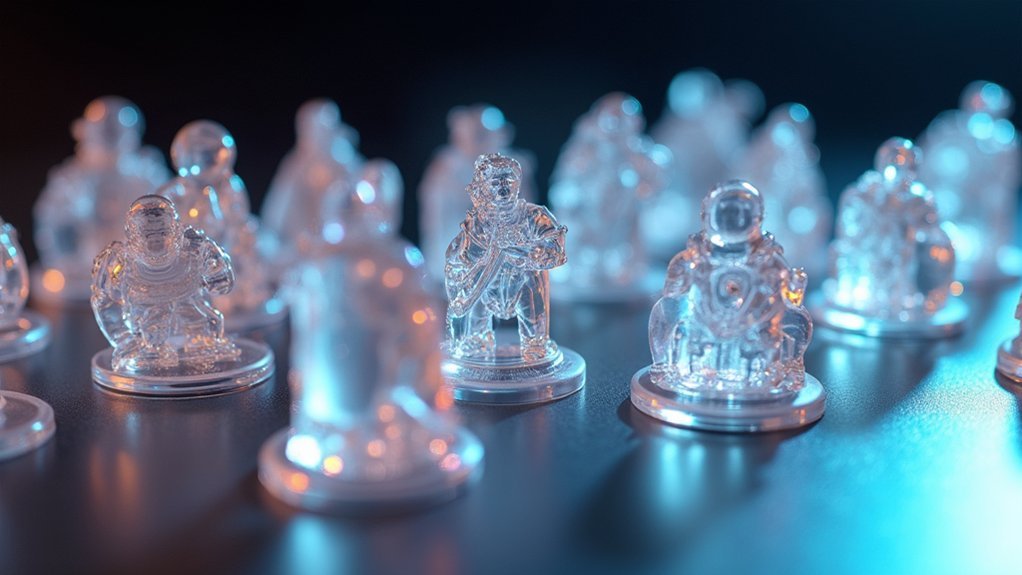
When you need gaming accessories that can withstand repeated handling while maintaining excellent optical properties, PETG filament delivers superior performance over standard PLA options.
This transparent filament combines exceptional durability with crystal-clear results, making it perfect for miniature bases, protective cases, and display components.
PETG’s low shrinkage and excellent layer adhesion guarantee your clear plastic parts maintain structural integrity without warping.
You’ll appreciate its non-toxic, food-safe properties when creating accessories for gaming environments.
For ideal transparency, print at 230-250°C with slower speeds of 20-40 mm/s to minimize light diffusion between layers.
Unlike other materials requiring extensive finishing, PETG needs minimal post-processing.
Simply apply a clear coat to enhance gloss and clarity for professional-looking transparent gaming accessories.
Resin Printing for Crystal-Clear Miniature Details
While filament printing produces acceptable transparent parts, resin printing technologies like SLA and DLP deliver unmatched crystal-clear results for gaming miniatures.
You’ll achieve smoother surfaces with fewer visible layer lines using clear resin compared to traditional filament methods. These techniques allow 100% infill density, creating realistic transparent components.
You should use layer heights between 0.025 to 0.05 mm to minimize light scattering and maximize transparency.
Post-processing is essential—cure your prints with UV light and polish them to remove haze and enhance optical clarity.
Specially formulated resins like VeroClear and LithaGlass provide exceptional transparency, making them perfect for intricate gaming miniatures requiring precise detail and visual appeal.
Resin printing delivers the crystal-clear results you need for professional-quality transparent gaming accessories.
Optimal Print Settings for Maximum Clarity
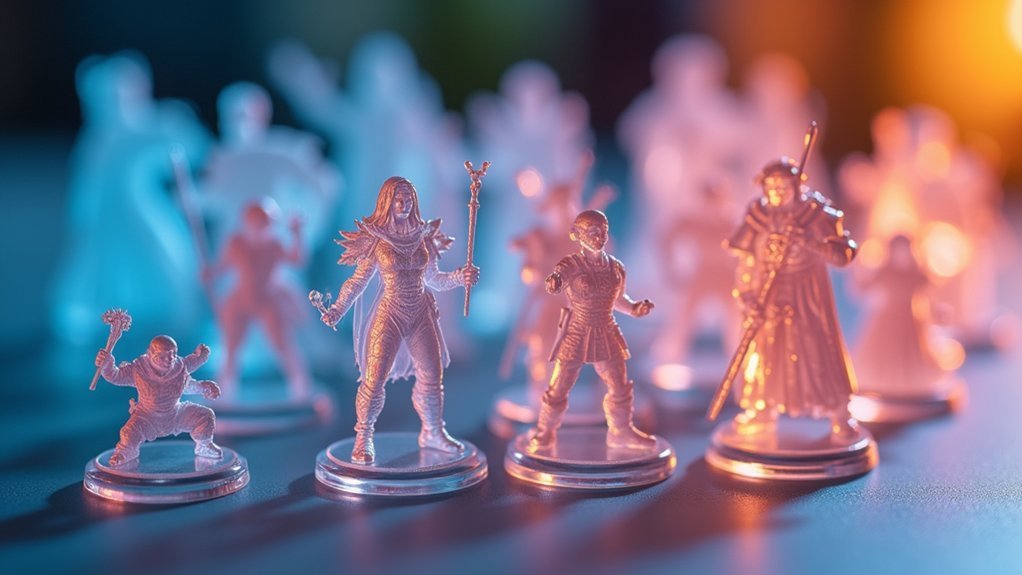
You’ll need to adjust several key print settings to achieve maximum clarity in your transparent gaming miniatures.
Your layer height, infill density, and wall thickness directly impact how light passes through the final print.
Getting your speed and temperature settings right guarantees consistent material flow that minimizes visual defects.
Layer Height Settings
The foundation of crystal-clear gaming miniatures starts with selecting the right layer height for your printing technology. Your choice dramatically impacts the final transparency and surface quality of translucent parts.
For resin-based printing technologies, you’ll want to dial in your layer height between 0.025-0.05 mm. This ultra-fine setting minimizes visible layer lines that can scatter light and reduce clarity. However, if you’re working with an FDM printer, you’ll need a completely different approach. Set your layer height to 0.2 mm or higher to improve layer fusion, which is absolutely critical for clear filament success.
| Technology | Recommended Layer Height | Purpose |
|---|---|---|
| SLA/DLP/LCD | 0.025-0.05 mm | Minimize layer lines |
| FDM | 0.2+ mm | Improve layer fusion |
Infill and Walls
Three critical wall and infill adjustments can transform your gaming miniatures from cloudy disappointments into crystal-clear masterpieces.
Set your infill to 0% for transparent parts, as any internal plastic creates light scattering that destroys clarity. You’ll maintain structural integrity while maximizing transparency.
Configure a single perimeter wall to minimize internal surfaces that scatter light. This approach reduces the number of boundaries light encounters while preserving strength for gaming use.
Increase your wall line width to improve layer adhesion, which eliminates visible layer lines that compromise optical quality.
Limit top layers to 1-2 maximum, allowing light to pass through unobstructed.
These walls and infill settings work together to create gaming miniatures with professional-grade transparency that’ll impress at any tabletop session.
Speed and Temperature
Beyond wall configuration, your printer’s speed and temperature settings directly impact the optical quality of clear gaming miniatures.
When printing filament for clear 3D printing, you’ll need to balance precision with proper heat management.
Your speed settings are vital for transparency. Slower printing speeds of 20–40 mm/s guarantee consistent extrusion and minimize surface defects that scatter light. This deliberate pace allows the printing filament to flow smoothly, creating the glass-like finish you’re after.
Temperature management requires equal attention:
- Maintain high bed temperatures to prevent warping and secure proper adhesion
- Use ideal nozzle temperatures for your specific clear filament type
- Keep chamber temperatures stable to avoid thermal stress
These speed and temperature adjustments work together, transforming ordinary clear filament into professional-quality transparent miniature components.
Post-Processing Techniques to Enhance Transparency
While achieving excellent transparency starts with selecting the right filament and optimizing print settings, you’ll find that post-processing techniques can dramatically transform your clear gaming miniature parts from merely functional to truly stunning.
Start with sanding using progressively finer grits, then wet-sanding to eliminate layer lines that scatter light and reduce optical clarity. For PMMA materials, carefully use a heat gun to melt the surface slightly, creating a smoother finish.
Always clean resin prints with isopropyl alcohol before UV curing to prevent yellowing or cloudiness.
Apply a clear coat through spray-on or brush-on finishes to add gloss and depth. You’ll achieve the best results by combining techniques—sanding followed by clear coating delivers exceptional visual outcomes for your transparent miniature components.
Comparing FDM Vs SLA for Clear Gaming Parts
When you’re choosing between FDM and SLA for clear gaming miniatures, you’ll notice SLA consistently delivers superior optical clarity with glass-like finishes that FDM can’t match.
The layer resolution differences are dramatic—SLA’s 0.025-0.05mm layers create nearly invisible lines while FDM’s thicker layers produce visible stepping that clouds transparency.
You’ll also find SLA requires less aggressive post-processing to achieve professional results, whereas FDM parts need extensive sanding and polishing to approach similar clarity levels.
Technology Clarity Differences
Although both FDM and SLA technologies can produce clear gaming miniature parts, the quality differences between them are dramatic.
You’ll immediately notice that SLA printers deliver true optical clarity with minimal layer lines, while FDM typically produces translucent parts with a cloudy finish.
The fundamental difference lies in how each technology works:
- SLA uses UV light to cure resin, creating smoother surfaces designed for high transparency.
- FDM extrudes clear 3D printer filament through heated nozzles, leaving visible layer lines.
- SLA resins achieve superior optical clarity compared to even premium PETG filaments.
When you’re choosing between technologies, consider that FDM requires extensive post-processing like sanding and polishing to improve clarity, while SLA prints need minimal finishing to achieve professional optical results for your gaming miniatures.
Layer Resolution Impact
Since layer resolution directly determines the final surface quality of your clear gaming miniatures, understanding how FDM and SLA technologies handle fine details becomes essential for achieving professional results.
FDM printing technology requires layer heights of 0.2mm or higher for proper fusion, creating visible lines that scatter light and reduce optical clarity. In contrast, SLA can achieve remarkable 0.025mm layer resolution, producing smoother surfaces with minimal light interference.
This dramatic difference in layer resolution explains why SLA consistently delivers superior clear parts for gaming applications. When you’re seeking true transparency in miniature components, the finer layer resolution of SLA printing technology becomes the decisive factor in achieving the optical clarity necessary for professional-grade gaming pieces.
Post-Processing Requirements
While SLA prints emerge from the build platform with inherently smooth surfaces requiring minimal finishing work, FDM clear gaming parts demand extensive post-processing to achieve acceptable transparency levels.
When printing clear miniature components, you’ll face noticeably different post-processing requirements depending on your chosen technology:
- FDM parts require sanding through multiple grits, polishing compounds, and clear coating applications to eliminate layer lines that scatter light.
- SLA prints need only basic cleanup and light sanding before achieving optical clarity.
- Surface quality from SLA resins designed for transparency delivers superior results with minimal effort.
Your FDM prints can achieve clarity with materials like PETG, but you’ll invest considerable time in post-processing.
SLA’s smooth output and 100% infill capability mean you’ll spend less time finishing while achieving better transparency results for your gaming miniatures.
Material Selection Based on Miniature Size and Function
When selecting filaments for clear gaming miniature parts, you’ll need to match your material choice to both the size and intended function of your models.
For intricate 28mm to 54mm miniatures requiring maximum detail, resin printing delivers superior optical clarity and precision that’s essential for small-scale features.
When printing clear miniatures using FDM methods, PLA or PETG becomes your best option depending on requirements. PLA+ works well for smaller pieces when you need decent transparent qualities, while PETG offers better durability for larger, more robust miniatures that’ll see frequent handling.
Consider your miniature’s function—display pieces can prioritize maximum clarity with resin, while gaming pieces benefit from PETG’s toughness and reasonable transparency for practical use.
Frequently Asked Questions
Is PETG or PLA Better for Transparent?
You’ll find PETG superior for transparent prints. It’s more durable, crack-resistant, and achieves better clarity than PLA. PETG requires less post-processing and offers superior layer adhesion, making it ideal for clear applications.
Is PLA or PETG Better for Miniatures?
You’ll find PETG better for miniatures requiring transparency and durability since it offers superior clarity and impact resistance. However, if you’re prioritizing ease of printing and don’t need transparency, PLA works fine.
What Is the Best Filament Material for Miniatures?
You’ll get the best results with resin-based filaments from SLA or DLP printers for miniatures. They produce smooth, detailed surfaces with minimal layer lines, creating professional-quality gaming pieces every time.
Is PLA or PETG Better for Mechanical Parts?
You’ll find PETG’s superior for mechanical parts because it’s more durable, flexible, and less brittle than PLA. PETG won’t crack under stress and handles repeated movement better than PLA’s rigid nature.

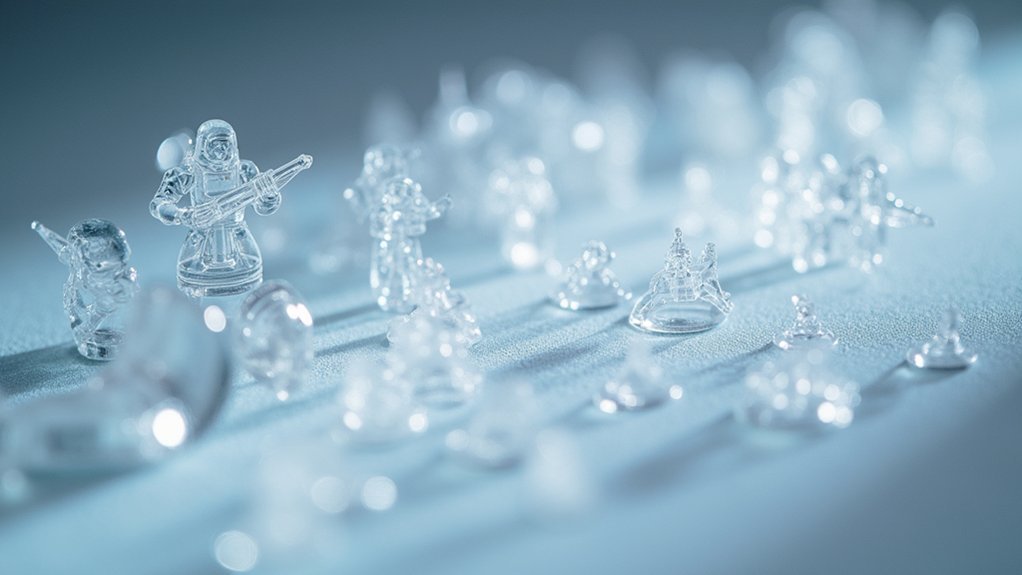
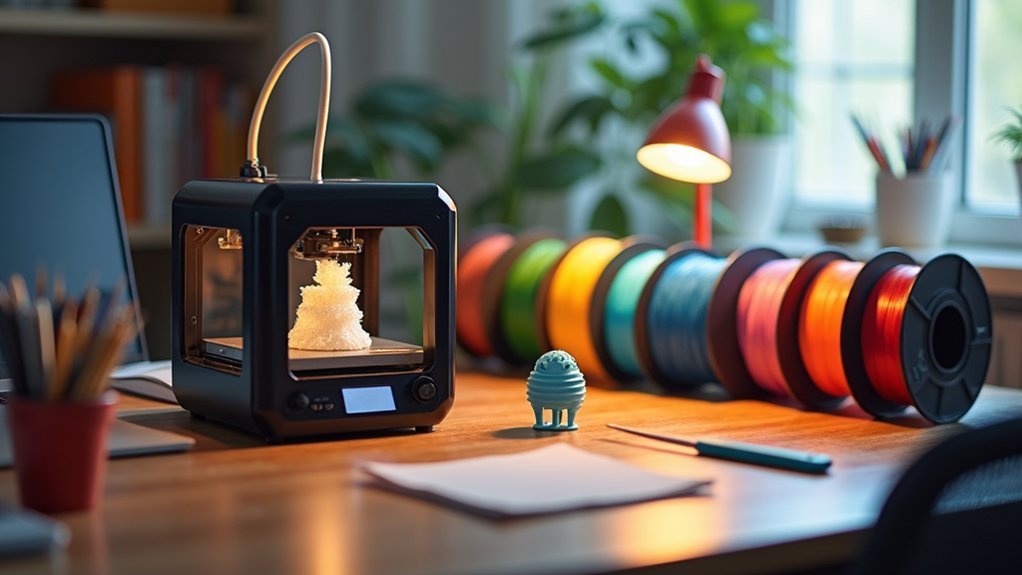
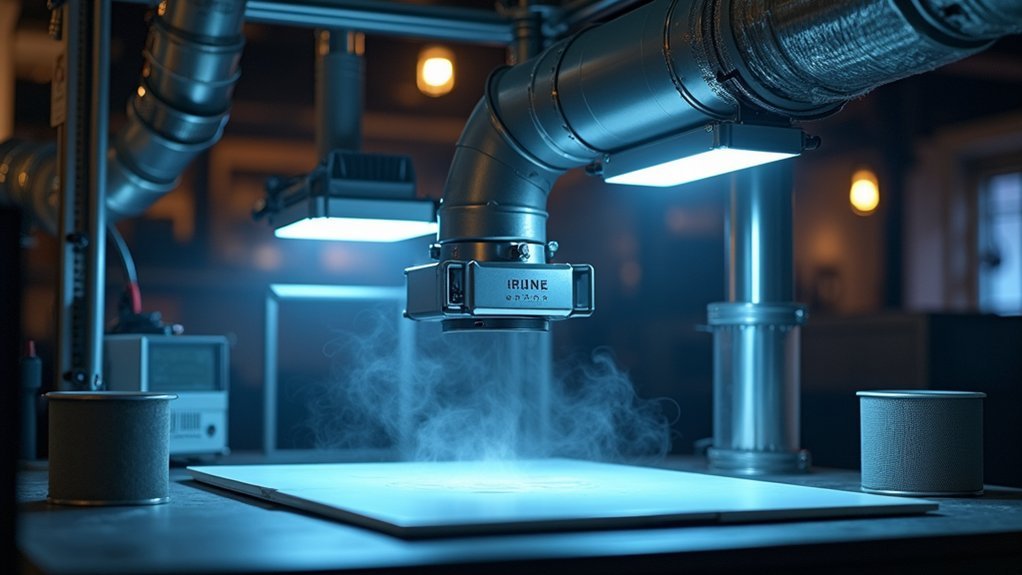
Leave a Reply